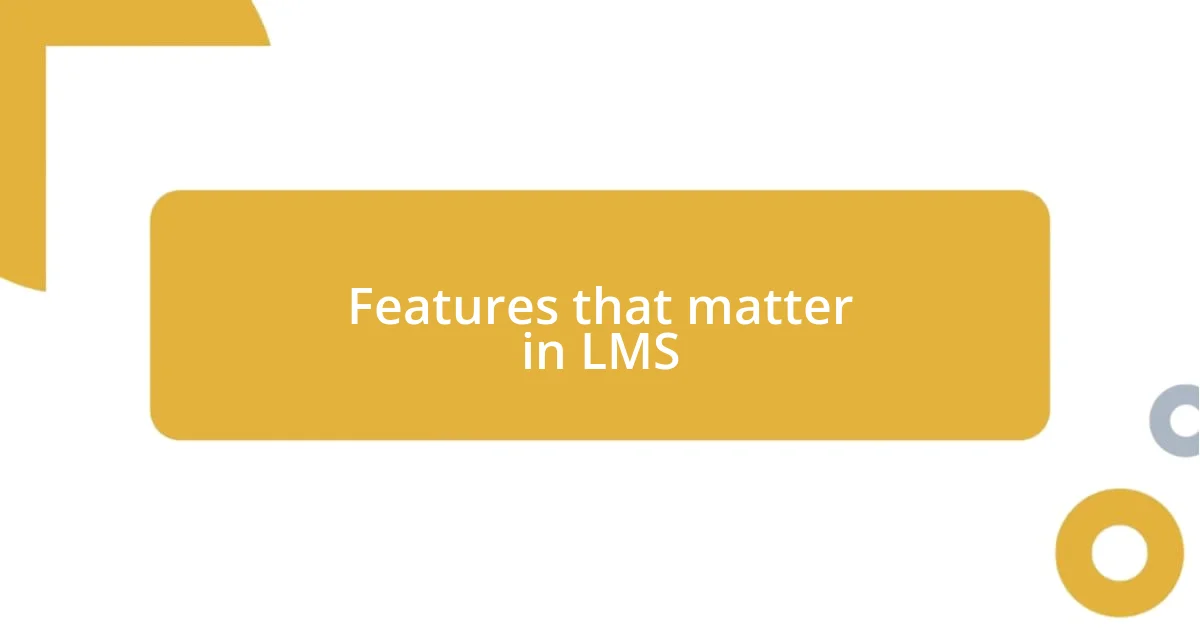Key takeaways:
- Usability, support, and customization are crucial factors when selecting a Learning Management System (LMS) as they directly enhance the learning experience.
- Features like interactivity, analytics, and mobile accessibility significantly contribute to engagement, motivation, and convenience in learning environments.
- Integration capabilities and transparent pricing options impact user satisfaction, productivity, and overall investment value in an LMS.

Reasons to choose an LMS
When it comes to choosing an LMS, one of the key reasons is usability. I remember the first time I had to navigate a complicated platform for a course—it was overwhelming! A user-friendly interface can make a world of difference, allowing learners to focus on the content rather than struggling with the technology itself. Isn’t it frustrating when you spend more time figuring out how to use the system than actually learning?
Another significant factor is the level of support the LMS provides. I once had an issue with an assignment submission on a different platform, and the help I received was so slow that I nearly missed a deadline. That experience taught me the importance of an LMS that offers reliable customer support and resources. Wouldn’t you want to know that help is just a click away when you encounter technical difficulties?
Customization features can also play a critical role in selecting an LMS. In my experience, being able to tailor the learning environment to fit specific needs and preferences creates a more engaging experience. For instance, the last LMS I used allowed me to adapt the dashboard to highlight my favorite courses and track progress easily. Don’t you think having that level of personalization can enhance motivation and learning outcomes?

Features that matter in LMS
Usability is just the tip of the iceberg when it comes to what truly matters in an LMS. Beyond the basic navigation, I value features that enhance interaction, such as discussion forums and live chat options. I recall a time when my peers and I stayed engaged during a course because we could easily bounce ideas off each other in the chat rooms. It transformed the experience from solitary learning into a vibrant community.
Another essential element is the reporting and analytics capabilities of the LMS. I’ve experienced platforms that provided insights into my learning patterns, helping me identify areas where I needed improvement. There’s nothing quite like seeing a visual representation of your progress—it’s motivating and offers a clear path for growth. Can you imagine feeling empowered knowing exactly where to focus your efforts?
Lastly, mobile accessibility is a non-negotiable feature for me. As someone who often learns on-the-go, I appreciate an LMS that prioritizes responsive design. One time, I was commuting and took a quick review of my course materials on my phone, and it made all the difference in keeping me connected to my studies. Wouldn’t it be great if every LMS offered that flexibility?
| Feature | Importance |
|---|---|
| Usability | Helps learners focus on content rather than technology |
| Interactivity | Encourages engagement and community |
| Analytics | Provides insights on learning progress and areas for improvement |
| Mobile Accessibility | Allows learning from anywhere, enhancing flexibility |

Comparing user interface designs
User interface design can truly shape the learning experience, influencing how easily I can navigate through courses and engage with content. I can’t help but remember the time I switched to a different LMS that boasted a sleek, intuitive design. Suddenly, finding materials was a breeze! I felt energized rather than frustrated while exploring course content. An aesthetically pleasing interface can also boost motivation—who doesn’t like a clean, organized space that invites exploration?
When I think about my experiences, I often realize that certain design elements make a difference in how I interact with the platform. Here are a few aspects that stand out to me:
- Simplicity: The best designs eliminate unnecessary clutter, allowing me to focus on the essentials.
- Consistent Navigation: I appreciate platforms with uniform menus; they help me feel oriented and confident as I explore.
- Visual Cues: Icons and colors that signify different actions or sections offer helpful guidance, making me feel like I’m on a clear path.
- Accessibility Features: Designs that consider diverse user needs ensure everyone can participate seamlessly, which is crucial in a learning environment.
Ultimately, it’s those thoughtful details in UI design that create a welcoming atmosphere, making learning feel less like a chore and more like an enjoyable journey.

Importance of customer support
Customer support is a cornerstone of any Learning Management System (LMS) that can often make or break the user experience. I remember the relief I felt when I had a question about a tricky feature and could chat with a knowledgeable support team promptly. It’s like having a safety net—knowing that help is available when complications arise can significantly enhance the learning journey. Isn’t it reassuring to think that support is just a message away?
Moreover, the availability of robust customer support fosters a sense of community and trust in the platform. I once faced a technical glitch during a crucial assignment deadline, and the response from the support team was both quick and effective. They guided me through troubleshooting in real-time, which not only resolved my problem but also made me feel valued as a learner. Does it feel different when you know there’s a team ready to back you up?
Lastly, the quality of customer support can significantly influence overall satisfaction with an LMS. While many platforms tout their features, the reality is that sometimes things don’t go as planned. A good support system anticipates users’ needs and addresses them proactively. I’ve often found moments of clarity and confidence when a support representative took the time to understand my issue and offer comprehensive solutions. Isn’t that the kind of experience we all hope for when we invest in our education?

Evaluating pricing options
When evaluating pricing options for an LMS, I always find myself weighing the true value against the cost. It’s not just about the sticker price; I consider what features I’d actually use and how they align with my learning goals. For instance, I remember when I hopped on a subscription that seemed affordable at first, but soon realized I was missing critical integrations that would have saved me time and effort. Have you ever found yourself in a similar situation, feeling the pinch after the initial allure of a low price?
Moreover, I think about hidden costs that can sneak up on you. Some platforms, while inexpensive upfront, charge extra for essential features like premium content or advanced analytics. I once faced a scenario where the basic plan didn’t include the collaborative tools I desperately needed for my team projects. It made me question if those initial savings were worth my continued struggle. Isn’t it fascinating how what appears to be a bargain can turn into a budget drain?
I also appreciate platforms that provide clear pricing tiers, as transparency really matters to me. Knowing exactly what I’ll get at each price point helps me plan and choose the one best suited for my needs. In my experience, those who take the time to break down their offerings upfront show a commitment to their users. Doesn’t it feel reassuring when you know what you’re agreeing to without any surprises lurking around the corner?

Assessing integration capabilities
Assessing integration capabilities
When choosing an LMS, I often focus on integration capabilities because they can truly make or break how I function in a digital learning environment. For instance, I remember attempting to synchronize my LMS with various tools like Google Drive and Zoom; the ease of integration determined whether my workflow felt seamless or fractured. Have you ever felt the frustration of working with clunky software that simply wouldn’t cooperate with your favorite tools? I know I have.
In my experience, a platform that supports multiple integrations not only enhances productivity but also fosters a holistic learning environment. Once, while using an LMS with limited integration options, I had to manually transfer data between applications, which felt like a massive time sink. I found myself gravitating toward a system that connected effortlessly with my other educational platforms. Isn’t it great when technology just works together without friction?
Moreover, I’ve discovered that the flexibility of integrations often reflects the LMS’s overall adaptability. I was pleasantly surprised how easily an all-in-one platform allowed me to import course materials and track analytics across tools. It made me realize how important it is for learners to have a cohesive technological ecosystem. Have you considered how integration can impact your ability to stay organized and focused during your studies? Trust me, a well-integrated LMS can significantly reduce stress and boost efficiency.

Personal experience with chosen LMS
One of the key reasons I prefer my chosen LMS is the user experience it offers. I still remember the first time I logged in; everything just clicked. The layout was intuitive, and I found myself navigating through courses like it was second nature. Have you ever experienced that feeling of excitement when technology just works? For me, that was a huge plus, reducing the time I spent figuring things out and letting me focus on learning instead.
I also appreciate the support community that comes with my LMS. During a recent project, I hit a technical snag, and I was amazed at how quickly I found help. Within minutes, I was chatting with someone who understood my issue and guided me through the solution. Doesn’t it feel like a lifeline when you know support is readily available? This strong sense of community has made a big difference in my learning journey—it fosters collaboration and a shared sense of purpose, making the process more enjoyable.
Lastly, I’ve been impressed by the regular updates and enhancements that my LMS undergoes. I recall a specific instance where they rolled out an upgrade that dramatically enhanced the mobile app experience. I was initially frustrated with the app’s limitations, but that update opened up a whole new way for me to engage with content on the go. Have you ever had a moment where an unexpected improvement made all the difference? For me, these thoughtful upgrades reflect a commitment to users and keep me coming back for more.













